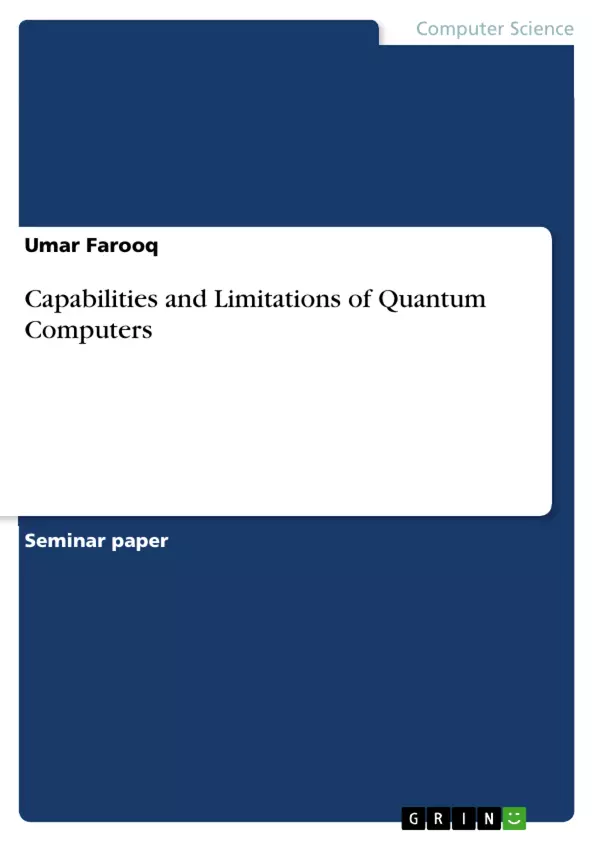Computers are evolving and growing for the last half a century. They are becoming smaller, faster and powerful but this growth has a limit. A new research has begun which will result in an entirely new kind of computer based on the Quantum physics rules. The quantum computer working on the Quantum physics rules will be able to break the security codes on which our modern computer infrastructure is running. The Quantum computers can solve many problems which are not solvable by the current computer systems. The large scale production of the quantum computers is near, which will result in many opportunities and every field of life will be affected.
Table of Contents
- I. INTRODUCTION
- II. RELATED WORK
- III. HISTORY OF QUANTUM COMPUTING
- IV. QUANTUM LANGUAGES
- V. HIGH PERFORMANCE QUANTUM COMPUTING
- VI. CAPABILITIES AND LIMITATIONS
- A. Cryptography and Quantum Computing
- B. Quantum Algorithms
- C. Security and Quantum Computing
- D. Complexity and Quantum computation
- VII. PRACTICAL QUANTUM COMPUTERS AND RELATED RESEARCH
- CONCLUSIONS
Objectives and Key Themes
This paper aims to provide a comprehensive overview of the capabilities and limitations of quantum computers, exploring their potential impact on various fields and the challenges that still need to be addressed. Key themes explored in the paper include:- The fundamental principles and architecture of quantum computers.
- The potential applications of quantum computing in diverse areas, including cryptography, algorithms, and high-performance computing.
- The challenges and limitations associated with the development and implementation of quantum computers.
- The impact of quantum computing on security, communication, and complexity theory.
- The current state of research and development of practical quantum computers.
Chapter Summaries
- I. INTRODUCTION: This chapter introduces the concept of quantum computing and its potential to revolutionize computing as we know it. The chapter highlights the capabilities of quantum computers in solving complex problems and their potential impact on various fields. The chapter also touches upon the security implications of quantum computing.
- II. RELATED WORK: This chapter discusses existing research and developments in quantum computing, exploring various approaches and technological advancements. The chapter focuses on the use of 3-dimensional cluster lattices, the development of physical models for quantum computer registers, and the use of ion traps for building quantum computers.
- III. HISTORY OF QUANTUM COMPUTING: This chapter provides a historical overview of the development of quantum computing, outlining significant milestones and advancements in the field. The chapter details key events such as the creation of the first 7-qubit quantum computer, the successful implementation of Shor's Algorithm, and the development of 16-qubit quantum computers.
- IV. QUANTUM LANGUAGES: This chapter explores the development of quantum programming languages, focusing on the challenges of creating languages capable of handling the unique concepts of quantum computation. The chapter discusses the limitations of standard semantics and the need for new approaches to quantum language design.
- V. HIGH PERFORMANCE QUANTUM COMPUTING: This chapter examines the potential of high-performance quantum computing, exploring how it can address computationally intensive problems. The chapter discusses the use of parallelization techniques for solving memory-bound problems and the development of quantum computers with global lattice architectures.
- VI. CAPABILITIES AND LIMITATIONS: This chapter delves into the capabilities and limitations of quantum computers. The chapter highlights their potential to solve problems that are infeasible for traditional computers and their advantages in performing multiple transactions simultaneously. However, it also emphasizes the challenges of scalability and noise distortion. This chapter is further divided into sub-sections:
- A. Cryptography and Quantum Computing: This section explores the impact of quantum computing on cryptography. The chapter discusses the use of quantum cryptography for secure communication, the potential risks posed by quantum computers to existing cryptosystems, and the potential for new cryptographic algorithms.
- B. Quantum Algorithms: This section explores the development of quantum algorithms. The chapter discusses algorithms such as Grover's search, Simon's Algorithm, and quantum factoring algorithms. It highlights the potential speed-ups offered by quantum algorithms for specific problems.
- C. Security and Quantum Computing: This section examines the security implications of quantum computers. The chapter discusses the need for new security measures in the era of quantum computers and the potential challenges posed by quantum adversaries. It also highlights the security advantages of quantum cryptography.
- D. Complexity and Quantum Computation: This section explores the relationship between complexity theory and quantum computing. The chapter discusses the implications of quantum computing for computational complexity, quantum interactive proof systems, and quantum complexity measures.
- VII. PRACTICAL QUANTUM COMPUTERS AND RELATED RESEARCH: This chapter discusses the development of practical quantum computers. The chapter highlights the work of D-Wave Systems, a leading company in the field, and the research efforts at the University of Waterloo. The chapter emphasizes the ongoing research and development of quantum computers and their potential to transform the computing landscape.
Keywords
This paper focuses on the emerging field of quantum computing, examining its capabilities and limitations. Key topics include quantum computers, qubits, computation, complexity, cryptography, quantum algorithms, security, and high-performance quantum computing. The paper explores both the potential of quantum computers to solve complex problems and the challenges associated with their development and implementation.
Excerpt out of 6 pages
- scroll top
- Quote paper
- Umar Farooq (Author), 2014, Capabilities and Limitations of Quantum Computers, Munich, GRIN Verlag, https://www.grin.com/document/272738
Look inside the ebook



